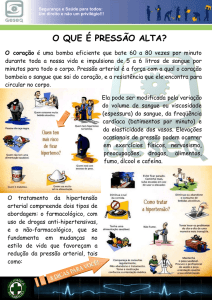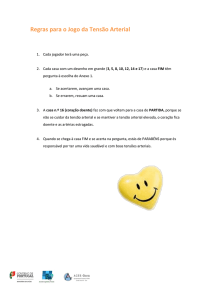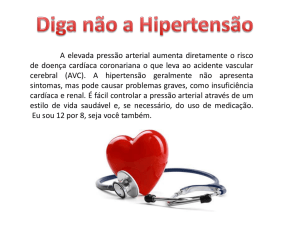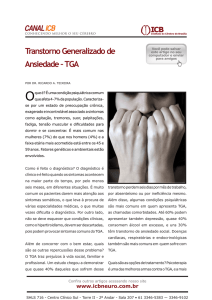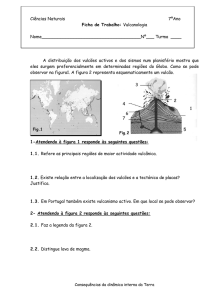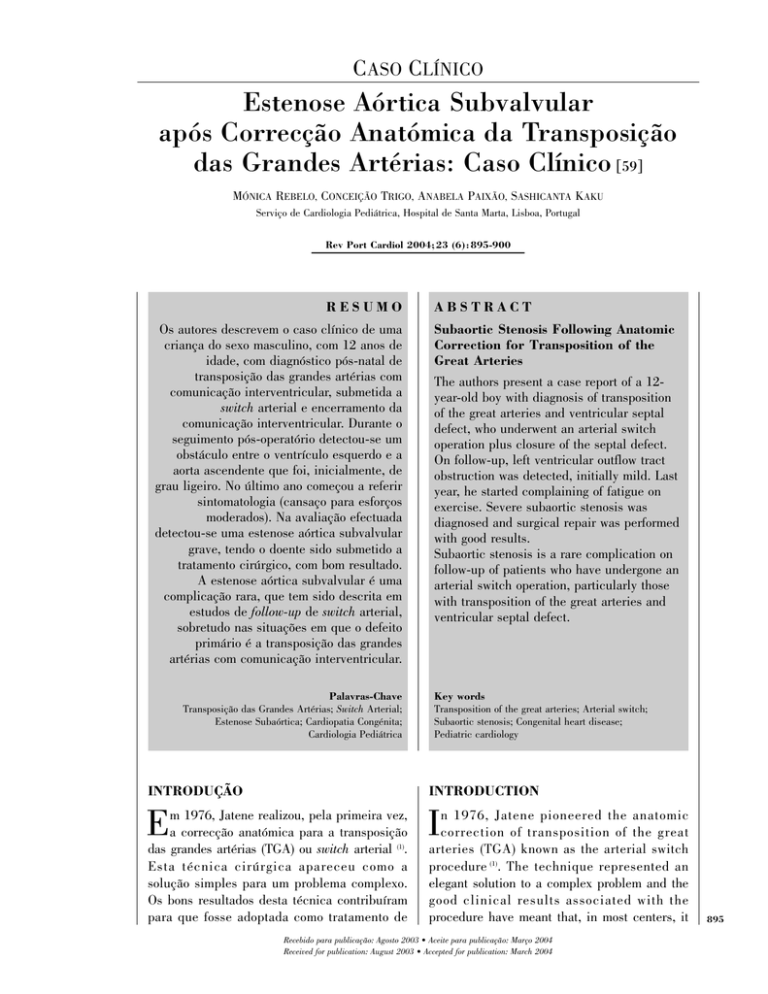
CASO CLÍNICO
Estenose Aórtica Subvalvular
após Correcção Anatómica da Transposição
das Grandes Artérias: Caso Clínico [59]
MÓNICA REBELO, CONCEIÇÃO TRIGO, ANABELA PAIXÃO, SASHICANTA KAKU
Serviço de Cardiologia Pediátrica, Hospital de Santa Marta, Lisboa, Portugal
Rev Port Cardiol 2004; 23 (6) : 895-900
RESUMO
Os autores descrevem o caso clínico de uma
criança do sexo masculino, com 12 anos de
idade, com diagnóstico pós-natal de
transposição das grandes artérias com
comunicação interventricular, submetida a
switch arterial e encerramento da
comunicação interventricular. Durante o
seguimento pós-operatório detectou-se um
obstáculo entre o ventrículo esquerdo e a
aorta ascendente que foi, inicialmente, de
grau ligeiro. No último ano começou a referir
sintomatologia (cansaço para esforços
moderados). Na avaliação efectuada
detectou-se uma estenose aórtica subvalvular
grave, tendo o doente sido submetido a
tratamento cirúrgico, com bom resultado.
A estenose aórtica subvalvular é uma
complicação rara, que tem sido descrita em
estudos de follow-up de switch arterial,
sobretudo nas situações em que o defeito
primário é a transposição das grandes
artérias com comunicação interventricular.
Palavras-Chave
Transposição das Grandes Artérias; Switch Arterial;
Estenose Subaórtica; Cardiopatia Congénita;
Cardiologia Pediátrica
ABSTRACT
Subaortic Stenosis Following Anatomic
Correction for Transposition of the
Great Arteries
The authors present a case report of a 12year-old boy with diagnosis of transposition
of the great arteries and ventricular septal
defect, who underwent an arterial switch
operation plus closure of the septal defect.
On follow-up, left ventricular outflow tract
obstruction was detected, initially mild. Last
year, he started complaining of fatigue on
exercise. Severe subaortic stenosis was
diagnosed and surgical repair was performed
with good results.
Subaortic stenosis is a rare complication on
follow-up of patients who have undergone an
arterial switch operation, particularly those
with transposition of the great arteries and
ventricular septal defect.
Key words
Transposition of the great arteries; Arterial switch;
Subaortic stenosis; Congenital heart disease;
Pediatric cardiology
INTRODUÇÃO
INTRODUCTION
E
I
m 1976, Jatene realizou, pela primeira vez,
a correcção anatómica para a transposição
das grandes artérias (TGA) ou switch arterial (1).
Esta técnica cirúrgica apareceu como a
solução simples para um problema complexo.
Os bons resultados desta técnica contribuíram
para que fosse adoptada como tratamento de
n 1976, Jatene pioneered the anatomic
correction of transposition of the great
arteries (TGA) known as the arterial switch
procedure (1). The technique represented an
elegant solution to a complex problem and the
good clinical results associated with the
procedure have meant that, in most centers, it
Recebido para publicação: Agosto 2003 • Aceite para publicação: Março 2004
Received for publication: August 2003 • Accepted for publication: March 2004
895
896
primeira escolha para transposição das grandes
artérias, na maioria dos centros, a partir dos
anos 80 (2).
has been the treatment of choice for
transposition of the great arteries since the
1980s (2).
CASO CLÍNICO
CASE REPORT
Criança do sexo masculino com 12 anos de
idade, admitida no serviço de Cardiologia
Pediátrica do Hospital de Santa Marta com um
mês e meio de vida, por cianose e cansaço ao
mamar.
Pais
jovens,
saudáveis
e
não
consanguíneos, sendo os antecedentes
familiares irrelevantes.
Tratou-se de uma gravidez vigiada, sem
complicações. Parto eutócico às 37 semanas de
gestação, no Hospital da Horta – Açores. Peso
ao nascer 2380 g (LIG). Período neonatal sem
intercorrências.
Efectuado o diagnóstico de TGA com
comunicação interventricular (CIV), foi de
imediato submetido a atrioseptostomia de
Rashkind e, posteriormente, a switch arterial e
encerramento da CIV, aos dois meses de idade
(cirurgião: Dr. Manuel Pedro Magalhães).
Na avaliação pós-operatória destacava-se à
auscultação cardíaca, um sopro sistólico de
ejecção III/VI no bordo esternal esquerdo
(BEE); o electrocardiograma apresentava
bloqueio completo de ramo direito (Fig. 1) e o
ecocardiograma – CIV residual pequena e
alterações morfológicas dos tractos de saídas
ventriculares, designadamente: à esquerda,
anel aórtico estreito sem obstáculo significativo
e sem insuficiência aórtica; à direita,
ventrículo direito espessado, com obstáculo
pulmonar supravalvular moderado (gradiente
transpulmonar ± 50 mmHg).
A criança foi seguida em ambulatório,
mantendo-se assintomática e sem evidência de
agravamento das lesões residuais,
monitorizadas por ecocardiografia.
Aos seis anos foi internada para estudo
completo. Foram efectuados os seguintes
exames complementares de diagnóstico:
e
c
o
c
a
r
d
i
o
grama de stress com dobutamina e cintigrafia
de perfusão miocárdica, que não revelaram
alterações; cateterismo cardíaco para estudo
hemodinâmico, que demonstrou um gradiente
de pressão sistólica ventrículo esquerdo (VE) /
Aorta = 45 mm Hg, e estudo cinenangiográfico
que confirmou o estreitamento do tracto de
saída do VE.
O seguimento posterior não evidenciou
A 12-year-old boy was originally admitted
to the Pediatric Cardiology Department of
Santa Marta Hospital 6 weeks after birth with
cyanosis and fatigue during breast-feeding.
The parents were young and nonconsanguineous, without relevant family
history.
The pregnancy had been supervised and
uneventful and delivery was eutocic after 37
weeks gestation, at Horta Hospital in the
Azores. Birth weight was 2380 g (SGA) and the
neonatal period was without complications.
On diagnosis of transposition of the great
arteries and ventricular septal defect (VSD), he
immediately
underwent
Rashkind
atrioseptostomy and, two weeks later, the
arterial switch operation and closure of the
septal defect. The surgeon was Dr Manuel
Pedro Magalhães.
During postoperative assessment, a grade
III/VI systolic ejection murmur was detected at
the left sternal border during auscultation;
electrocardiography showed complete right
bundle branch block (Fig. 1) and
echocardiography indicated a small residual
VSD and morphological abnormalities of the
ventricular outflow tracts: on the left, a narrow
aortic annulus without significant obstruction
or aortic regurgitation, and on the right, a
thickened right ventricle with moderate
supravalvular pulmonary obstruction
(transpulmonary gradient ± 50 mmHg).
Follow-up was maintained on an out-patient
basis; the child remained asymptomatic and
echocardiographic monitoring did not detect
signs of worsening of the residual lesions.
At the age of six years, he was hospitalized
for a complete study. The following
complementary diagnostic tests were carried
out: dobutamine stress echocardiogram and
myocardial perfusion scintigraphy which
revealed no abnormalities; cardiac
catheterization
for
hemodynamic study which showed a left
ventricular-aortic pressure gradient of 45
mmHg; and a cineangiographic study which
confirmed narrowing of the left ventricular
outflow tract.
Subsequent follow-up showed no
Fig. 1 Electrocardiograma de superfície com 15 derivações evidencia Bloqueio Completo de Ramo Direito.
Fig. 1 15-lead surface electrocardiogram showing complete left bundle branch block.
progressão das lesões até Setembro de 2002,
altura em que surge com quadro de cansaço
para esforços moderados. Na auscultação
cardíaca detectou-se um sopro sistólico de
ejecção IV/VI no BEE irradiando para os vasos
do pescoço. O electrocardiograma apresentava
c
r
i
térios de hipertrofia ventricular esquerda
(Fig. 2), e o ecocardiograma mostrava
hipertrofia ventricular esquerda marcada,
insuficiência mitral moderada e obstáculo à
saída do VE com envolvimento de cordas
tendinosas da válvula mitral (Fig. 3), gerando
um gradiente VE/Aorta > 75 mmHg. O
cateterismo cardíaco demonstrou pressão
sistólica no VE de 220 mmHg com gradiente
VE/Aorta de 134 mmHg (Fig. 4). No estudo
angiocardiográfico confirmou-se a estenose
aórtica subvalvular fibromuscular, sem
insuficiência aórtica significativa.
Proposto e aceite para cirurgia de
desobstrução da câmara de saída do VE, foi
operado a 10 de Setembro de 2002, tendo sido
deterioration of the lesions up until September
2002, at which time the patient began
complaining of fatigue on moderate exercise.
Cardiac auscultation indicated a grade IV/VI
systolic ejection murmur in the left sternal
border radiating to the neck vessels.
Electrocardiography matched left ventricular
hypertrophy criteria (Fig. 2) and
echocardiography indicated marked left
ventricular hypertrophy, moderate mitral
regurgitation and obstruction of the left
ventricular (LV) outflow tract with involvement
of the chordae tendineae of the mitral valve
(Fig. 3), giving rise to an LV-aortic gradient >75
mmHg. Cardiac catheterization indicated LV
systolic pressure of 220 mmHg and LV-aortic
gradient of 134 mmHg (Fig. 4). Cardiac
angiography confirmed the presence of
fibromuscular subvalvular aortic stenosis,
without significant aortic regurgitation.
Having been proposed and accepted for
surgery to clear the LV outflow tract, the patient was operated on September 10 2002 with
Fig. 2 Electrocardiograma de superfície com 15 derivações evidencia Hipertrofia Ventricular Esquerda.
Fig. 2 15-lead surface electrocardiogram showing left ventricular hypertrophy.
897
Fig. 3
Ecocardiograma
transtorácico, plano paraesternal
eixo longo, revelando anatomia do
tracto de saída do ventrículo
esquerdo (VE).
AE: aurícula esquerda
Fig.
3
Transthoracic
echocardiogram, parasternal long
axis view, showing the anatomy of
the left ventricular outflow tract.
AE: left atrium.
e
f
e
c
tuada ressecção de membrana subaórtica, secção
de cordas anómalas da mitral e miotomia de
Morrow (cirurgião: Prof. Doutor José Fragata).
O pós-operatório decorreu sem complicações, e
verificou-se não haver gradiente residual
significativo no tracto de saída do VE por eco
Doppler (Fig. 5).
Teve alta clinicamente estável, com
indicação para profilaxia da endocardite
bacteriana e seguimento programado em
ambulatório.
resection of the subaortic membrane,
sectioning of the anomalous mitral chordae and
Morrow myectomy. The surgeon was Professor
Jo-sé Fragata. Post-operative recovery
proceeded without complications and Doppler
echo confirmed that there was no significant
residual
pressure gradient in the LV outflow tract (Fig. 5).
The patient was discharged in a clinically
stable state, with indications for prophylaxis
against bacterial endocarditis and for an outpatient follow-up program.
Fig. 4 Registo de pressão do ventrículo esquerdo (VE) e Aorta (Ao) com gradiente de pressão de 134 mmHg.
898
Fig. 4 Pressure readings for the left ventricle (LV) and aorta (Ao) with a pressure gradient of 134 mmHg.
Fig. 5
Ecocardiograma
transtorácico, plano paraesternal
eixo longo, revelando anatomia do
tracto de saída do ventrículo
esquerdo (VE).
AE: aurícula esquerda.
Fig.
5
Transthoracic
echocardiogram, parasternal long
axis view, showing the anatomy of
the left ventricular outflow tract.
AE: left atrium.
DISCUSSÃO
DISCUSSION
A TGA é a cardiopatia congénita cianótica mais frequente no período neonatal,
constituindo 5 a 7 % das malformações
cardíacas. A sua incidência varia de 20,1 a
30,5 por cada 100 000 nados-vivos, com
predomínio no sexo masculino (3).
Foi inicialmente descrita em 1797, por Matthew Baillie, em Londres, mas o termo
«transposição da aorta e artéria pulmonar» foi
introduzido em 1814 por Farre, em Londres. A
coexistência de CIV é frequente, ocorrendo em
40-45 % dos casos de TGA.
A cirurgia de switch arterial é o tratamento
de primeira escolha para as várias formas de
TGA, com bons resultados a curto e longo
prazo (4) . A mortalidade cirúrgica precoce
desceu de 15 %, no início dos anos 80, para
5 % em séries actuais, sendo a mortalidade
tardia em várias séries, igualmente baixa (5, 6, 7).
Nos doentes com TGA complexa há uma
maior prevalência de reoperações (8). A estenose
pulmonar continua a ser a principal causa de
reoperação, embora as alterações introduzidas
na técnica cirúrgica tenham vindo a reduzir
este problema (9). A obstrução do tracto de
saída do VE, sobretudo a subvalvular, tem sido
raramente descrita e apenas em situações de
TGA com CIV (8, 9).
Numa série de 195 doentes submetidos a
switch arterial, de 1977 a Junho de 2000 (9), 41
foram submetidos a reintervenção, mas apenas
um por estenose aórtica subvalvular, meio ano
após a primeira cirurgia. Este doente
apresentava, como lesão primária, TGA com
CIV subpulmonar e estenose do tracto de saída
TGA is the commonest congenital cyanotic
heart disease in the neonatal period and makes
up 5 to 7 % of cardiac malformation cases. Its
incidence varies from 20.1 to 30.5 for every
100 000 live births and it is predominantly
found in males (3).
The condition was originally described in
1797, by Matthew Baillie in London, and the
designation “transposition of aorta and
pulmonary artery” was coined in 1814 by
Farre, again in London. It is often found in
association with VSD, which is found in 4045 % of TGA cases.
Arterial switch surgery is the first choice
treatment for the various forms of TGA,
providing good results in the short and long
term (4). Early surgical mortality has fallen from
15 % in the early 1980s to 5 % in current
series, and long-term mortality in various
series is also low (5, 6, 7).
There is a higher prevalence of reoperation
for patients with complex TGA (8). Pulmonary
stenosis continues to be the main reason for
reoperation, although improved surgical
techniques have tended to reduce the problem
(9)
. Obstruction of the LV outflow tract,
particularly subvalvular, has rarely been
described and only in situations of TGA with
VSD (8, 9).
In a study of 195 patients who underwent
the arterial switch operation from 1977 through
June 2000 (9), 41 underwent reintervention but
only one of these was due to subvalvular aortic
stenosis, six months after the initial surgery.
This patient presented with TGA as the
899
do VE. Numa outra série, que incluiu 1200
doentes submetidos a switch arterial de 1982 a
1999 (8), foram submetidos a reoperação 103
doentes, num total de 128 reoperações. A
obstrução do TSVE foi a causa de reoperação
em nove casos, todos de TGA complexas.
CONCLUSÃO
primary lesion with subpulmonary VSD and
LV outflow tract stenosis. In another series of
1200 patients undergoing arterial switch between 1982 and 1999 (8), 103 were reoperated,
with a total of 128 reoperations. LV outflow
tract obstruction was the reason for reoperation
in 9 of these cases, all with complex TGA.
CONCLUSION
A obstrução do TSVE é uma complicação
rara da cirurgia de switch arterial, que ocorre
Pedidos de separatas para:
Address for reprints:
MÓNICA REBELO
Serviço de Cardiologia Pediátrica
Hospital de Santa Marta
Rua de Santa Marta
1169-024 LISBOA, PORTUGAL
E-mail: [email protected]
BIBLIOGRAFIA / REFERENCES
1. Jatene AB, Fontes VF, Paulista PP, et al. Anatomic
correction of transposition of great vessels. J Thorac
Cardiovasc Surg, 1976;72:364-70.
2. Daniel Sidi, Yves Lecompte. Transposition and Malposition of the Great Arteries with Ventricular Septal
Defects. In Moller and Hoffmann, eds. Pediatric
Cardiovascular Medicine. Philadelphia: Churchill
Livingstone,
2000;
363-73.
3. Gil Wernovsky. Transposition of Great Arteries. In Moss
and Adams, eds. Heart Disease in Infants, Children and
Adolescents. Philadelphia: Lippincott Williams & Wilkins,
2001;1027-84.
4. Prifti E, Crucean A, Bonacchi M, et al. Early and long
term outcome of the arterial switch operation for
transposition of the great arteries: predictors and functional
evaluation. Eur J Cardiothorac Surg, 2002;22:864-73.
5. Prêtre R, Tamisier D, Bonhoeffer P, et al. Results of
arterial switch operation in neonates with transposed great
arteries. Lancet 2001;357:1826-30.
6. Haas F, Wottke M, Poppert H, Meisner H. Long-term
survival and functional follow-up in patients after the arterial
switch operation. Ann Thorac Surg, 1999;68:1692-7.
7. Wetter J, Belli E, Sinzobahamvya N, Blaschzok HC,
Brecher AM, Urban AE. Transposition of great arteries
associated with ventricular septal defect: surgical results and
long-term outcome. Eur J Cardiothorac Surg, 2001;20:81623.
8. Losay J, Touchot A, Serraf A, et al. Late outcome after
arterial switch operation for transposition of great arteries.
Circulation, 2001;104(suppl I):I-121-I-126.
Reunião Anual do
Grupo de Estudos de Hemodinâmica
e Cardiologia de Intervenção
29 e 30 de Janeiro de 2005
Peniche, Praia d’El Rey
Marriott Golf & Beach Resort
900


